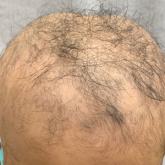Article

Adjuvant Scalp Rolling for Patients With Refractory Alopecia Areata
- Author:
- Jordan Phillipps, BS
- Bruin Pollard, MD
- Caroline Mann, MD
Dermatologists should be aware of scalp rolling as a safe, affordable, and potentially effective adjuvant to conventional therapy for alopecia...
